Alex Quigley's Blog, page 4
April 5, 2025
School Improvement: Detecting Voltage Drops

Making change in education is hard. Making a change at scale is even harder. Whether it is a new secondary school, growing their departments and staff, or a school trust mushrooming in size, this type of scale up can easily suffer what has been termed a ‘voltage drop’.
The book, ‘The voltage effect: How to make good ideas great and great ideas scale’, by John A. List explores a host of real-world examples to prove his point. In national policy, or in educational research, the challenges of scale-up are well known. It could be Jamie Oliver restaurants or BooHoo going boom and then bust.
John List also helpfully poses five critical issues to look out for when seeking to scale-up an idea or an organisation like a school or trust.
‘False positive’ indications of early success. A false positive is a misleading indicator of success that may not steer us to identity the key ingredients for effective scale up.
School level example: Teachers and middle leader are delighted by the reading intervention in their Scarborough secondary school. It is expensive but seems to be effective with very high need pupils. But when they expand the number of pupils, and the TAs to deliver, the reading advances start to fall away.
A lack of ‘audience’ understanding. Different groups can respond and interpret change and improvement in different ways. We may assume more similarities than differences in response when we are confident in our methods.
Trust level example: The host school of the Leeds trust always gets brilliant exam outcomes founded on their knowledge curriculum and extended day model. When those very same leaders work across a range of schools, implementing a new extended day structure, the same gains just aren’t evident.
School level example: A new year 6 approach to teaching the writing process goes well when teachers teach a couple of units. The school decide to run the approach across all key stage 2 classes. It quickly becomes evident that year 4 and year 5 pupils struggle with the degree of writing independence built into the approach.
A dependence on exceptional individuals. Brilliant people are hard to scale. With the staffing crisis, for teachers and leaders, this is particularly acute. Headteachers who have developed in a school and know it inside out may also not translate those insights in different schools.
Trust level example: Teachers and leaders in their growing Manchester trust get great feedback about their new homework and marking policies from parents. When the trust grows across the North West, they cannot seem to find the same level of positive opinion in their surveys when spread across parents and communities in their different schools.
School level example: A science department in a new start up school in Liverpool is achieving startling GCSE results with the first couple of cohorts of students. Only a few years later, with a department triple the size, results plateau (though still well above average). The quality of teaching and leadership is more variable, and the pupil demographics are beginning to change.
Negative spillover effects. Spillover effects can occur in unintended ways, with some negative side effects.
Trust level example: In a large primary school in Derby, a brilliant deputy headteacher leads out the implementation of an updated curriculum. But when you try and scale the same curriculum across a group of trust primaries, across the Midlands, it is communicated less clearly, and when it goes wrong people don’t see the issues quick enough. The brilliant deputy was vital and not-so-scalable.
School level example: A new secondary school-wide approach to using tablets gets lots of initial acclaim. Initial engagement and homework completion appears to improve. But there is also the reality that instances of copy-and-pasting homework from the web increases. Also, lots of pupils begin to experience tablet charging issues, which sees many pupils avoiding lesson starts and similar.
Avoiding cost traps. Scaling up can sometimes see an escalation in costs that accompany the change. Once we have started an improvement plan, it can be hard to withdraw, and we can often sink more costs into our plans in an attempt to secure success. Or, we can simply underestimate the hidden costs of an approach.
Trust level example: A new primary trust-wide communication plan focuses on moving to text and a small number of emails. Whilst this saves some initial time in parental meetings and chats with parents in mornings, it begins to see an issue with some vulnerable families being wholly out of contact, along with some parents demanding repeated meetings, above and beyond any previous home-school communication.
School level example: A large secondary school in Newham sees the success of an ‘attendance officer’ approach in the school down the road. They decide to do it with their existing pastoral team, but it quickly transpires they need additional full-time staffing to make it workable.
Trust level example: An intensive same-day intervention approach works effective in schools in the trust which have high pupil premium funding to support and train teaching assistants, but in schools with lower funding, the approach just stops being feasible.
There is no easy way to secure scale-up success, but a helping starting point is assuming the conditions for initial success will often be more unique and related to specific school contexts.
Understanding likely 'voltage drops' is a good start to planning and a useful issue to monitor as we seek to make an improvement in our schools or across the system more widely.
March 29, 2025
The 3Rs - Reading, writing, and research to be interested in #60

British summer time is about to begin and the year continues to tick over at pace. If things are moving a little too fast, perhaps take a few minutes to reflect and read about the latest reading and writing in education. This edition includes writing on the state of writing in schools, a new book on helping young children fend off distractions, as well as new research on worked examples and feedback, new EEF Teaching Assistant guidance, the curriculum interim report, and more.
What I am writing...My latest blog explores 'What is happening with writing?', drawing upon a recent EEF practice review exploring writing in primary and secondary schools in England. It concisely explores some of the key differences between writing at primary and secondary school, as well as the dearth of good assessment that may be masking key issues in writing development. READ MORE HERE.
My most popular blog in the spring was 'Adaptive Teaching: Scaffolds, Scale, Style and Structure'. It explores how teachers can adapt tasks in lessons to take into account adapting for scaffolds, the scale of the task, and some structure and style choices. It is practical and focused on supporting teachers to make manageable responses without differentiating to create multiple lessons. READ MORE HERE. You can also find the following free tool related to the blog on my RESOURCES PAGE HERE.
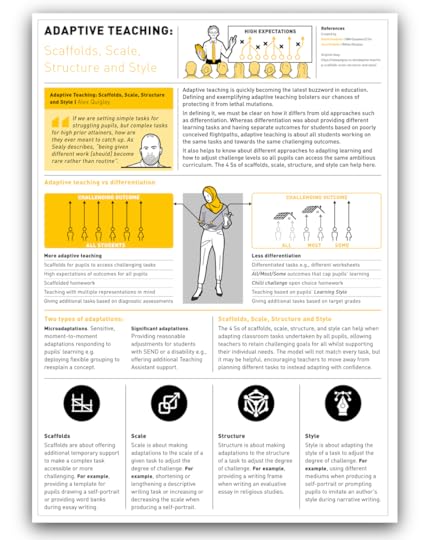 What I am reading...
What I am reading...Attention and distraction seem to be peristant issues in education right now. From mobile phones and media distraction, to the importance of attention for learning, the precious value of focusing in seemingly at a premium. An excellent new book by Prof Sam Wass and Dr Gemma Goldenberg, entitled 'Take Action on Distraction: The definitive guide on improving attention and focus in the Early Years and Key Stage One' explores the topic for young children in Early Years and Key Stage 1. It is a really compelling, evidence-rich, and accessible book. It explores expected topics such as classroom noise, and 'visible noise', along with better understanding neurodiversity and attention. I was struck by the helpful analogy of children who are 'dandelions' and 'orchids' (in how they respond to the environment), as well as how developing consistent environments (and 'schema') can really help young children. This was one of my favourite reads of the year so far. READ MORE HERE.
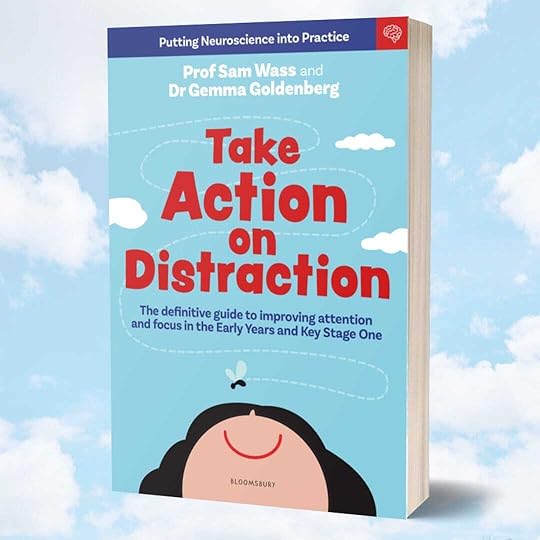 What research (and resources) to be interested in...
What research (and resources) to be interested in...The Education Endowment Foundation has updated its popular and long-standing 'Deploying Teaching Assistant' guidance report. It has a lot of consistency with previous research findings, but it makes an important shift to helpful clear messaging about how TAs can better scaffold pupils' independence. READ MORE HERE.
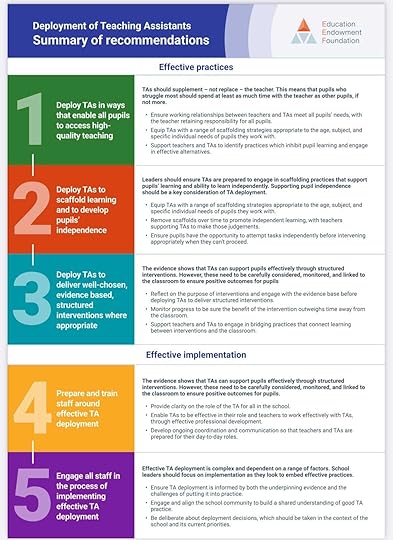
The Department of Education has now released its 'Curriculum and Assessment Review: Interim Report' which outlines the key debates and principles underpinning the prospective review outcomes due out in the autumn. READ MORE HERE.
How do we best teach using 'worked examples'? Teachers of students of every age deploy worked examples, but practice can be variable, and the example you pick really matters. A new study, with the title 'Teaching with worked examples – Why the selection of problems for exemplification is critical', exploring worked examples with a small study with university age students. It reveals how when students are given more ambiguous examples, rather than helping, it could possibly have a negative impact (inflating confidence and creating fuzzy understanding). READ THE RESEARCH HERE.
A new study by Zhang and Fiorella (2025), explores how getting students to explain their errors after feedback really aided understanding. Entitled, 'Effects of self-explaining feedback on learning from problem-solving errors', it reveals unsurprising findings that talk after feedback aids learning and student understanding of feedback. It is key we create space to support students to respond to their feedback meaningfully, or all that precious time won't be well spent. READ THE RESEARCH HERE.
What students are struggling in my school or college, why, and what can we do about it? My Teachology masterclass - live in Manchester and online - on 'Why Learning Fails (And How to Fix It)', occur only once more this academic year, tackling key issues to support all students who struggle with the school curriculum. It covers knowledge gaps, the issue of why students forget the curriculum, and how to help all students learn with greater independence and fend of 'learned helplessness'. FIND OUT MORE HERE.

March 22, 2025
What is happening with writing?

Writing problems, and solutions, can too often go undetected in schools. Unlike reading, there are relatively few specific writing assessments to detect issues that schools can use, so it is hard to follow clear trends. As a result, when national exams reveals issues – such as the drop in primary pupils’ writing post-pandemic, schools can be left with too little idea about what to do next.
When it comes to writing, it is important to understand the practices happening in busy schools. A recent practice review on writing by the Education Endowment Foundation, commissioned to explores avenues for new research, has some useful insights to better understand what is happening with writing in schools.
What were the key insights from the review for me?
How writing is approached is fundamentally different in primary and secondary school. In most secondary schools, writing instruction and interventions are where writing is located. Few whole school approaches exist. This is in stark contrast to primary school, where school-wide, cross-curricular approaches are common.
What are the implications of this practice finding?
Training, assessments, curriculum materials, will all need to be substantively different to support different teachers in different phases. One-size-fits-all approaches are unlikely to work across phases. A ‘disciplinary literacy’ approach will be needed in secondary – which is trickier, more nuanced, and harder to implement than generic writing approaches.
Schools are trying to support struggling writers with ‘build-your-own’ approaches and interventions. Writing lacks good diagnostic assessment as well as interventions to address problems that emerge through such assessment.
What are the implications of this practice finding?
School leaders, SENCOs, and teachers are likely to be ploughing collective energies in trying to help struggling writers. This is not likely to prove a workload friendly approach, and we are also unlikely to know if their efforts are working. The EEF will generate new, important research, but the curriculum is mediated by writing in countless ways, so writing will need to be a sustained priority in the school system.
At key stage 4, writing is tested through national English Language exams. The problem with these assessments is they don’t tell us a great deal about the specific writing issues schools and teachers care about.
What are the implications of this practice finding?
It confirms what we already know: GCSE specifications drive practice. In secondary school, reading and writing instruction is a pale shadow of the high-stakes exams students sit. Such practice is unlikely to have the focused support on writing features, such as handwriting and spelling limitations, grammar issues, or limited expression.
In short, when we explore what is happening with writing in English schools, we likely need more of the following:
Better writing assessments (that are adapted for primary and secondary)Better writing curricula (particularly sensitive to subject disciplines in secondary school)Better interventions for struggling writersBetter training for teachers to identify problems and to enhance their universal approach to writing in the classroom.Better guidance on how to use, or not use, national assessments as a proxy for diagnosing writing problems and development.Related:
The Education Endowment Foundation has commissioned a research round on writing in English primary schools that you can find out more about the trails and how to join them here: READ MORE HERE . The Education Policy Institute and Oxford University Press have just released a short paper on what is needed from policy to improve writing. It syncs well with the practice review conducted by the EEF: READ MORE HERE .
March 15, 2025
March 8, 2025
The 7 Deadly Sins of Exam Revision

Year after year, teachers conduct assemblies, workshops, and share resources on effective revision. Despite all that effort, students continue to fall for the all-too-common seven deadly sins of exam revision.
So, what are these ever-present sins that beset so many students?
Procrastination and cramming. Perhaps the most famous sin of all is procrastination. Leaving revision to little more than the night before. Cramming can have small gains, but only if you have already put in lots of work. There is no real solution that doesn’t require sustained effort, spaced over time. Working smarter, not just harder. Procrastination is all-too-human, so you need lots of prompts and you need to organise your environment to minimise distractions and fight off the urge to put revision off.[Instead: Put away your phone ; set daily goals ; reflect on your revision approaches ]
Passive revision approaches. Some revision strategies are passive and so give the illusion of learning but little more. Approaches such as re-reading and highlighting can keep you busy, but they can be done with very little actual thinking. Merely copying out notes from one source to another can require little active reorganisation or thinking. Will watching those catchy short videos on TikTok make all the difference to exam success? It is highly unlikely![Instead: self-test ; use flashcards ; teach a friend ; reorganise your notes ]
Skimping on sleep. Teenagers have different sleep rhythms. They want to sleep in and stay up late. But on a school day, they are up early, so they need to get to bed at a reasonable time too. Some students think staying up late at night is worth the pain and tiredness, but the extra hour or two in the evening may negatively damage your precious sleep and your learning. It is sleep which helps provides that precious time for your brain to process, organise, and store your memories.[Instead: some learning before sleep may be helpful; secure a minimum of 7 hours sleep ; limit tech is the evening ]
Poor time-management. We can all assume doing big blocks of study can be effective, but ‘massed practice’ can often give an illusion of learned material and successful revision. Ironically, students may be able to revise more effectively in less time. As we know, cramming is poor time management but so is studying for a given topic and then testing yourself straight away. It gives the illusion of remembering and so proves to be time poorly organised. Students need to self-monitor and take breaks to maximise the impact of their revision, so they are fresh enough to think hard and experience a little struggle.[Instead: space out revision ; take breaks ; use the Pomodoro technique ; mix up your topics carefully ]
Overconfidence in what has been learned. Confidence is a good thing, right? Well, well it comes to revision, overconfidence is typically a problem. Just re-reading our notes can make us feel familiar and fool ourselves we know the answers (a ‘feeling of knowing’). Even university students drop flashcards too early assuming they know the content with confidence. We need to puncture overconfidence and pursue a Goldilocks approach – not too much, not too little, but just right.[Instead: Get them to explain what they know to others ; use confidence tests & exam wrappers ]
Accepting weapons of mass distraction. Phones, laptops, music and friends – all the good stuff every teenager likes. Well, when it comes to revision, what you like invariably pushes out what you need to think and do! The presence of laptops and phones can prove a distraction, rather than a productive tool. Certain music can help live the mood of some students but interferes for others. We need to take care and reduce distraction wherever possible. No matter what students believe, you don't need your phone to revise![Instead: Use tech ‘focus’ apps ; stick to pen & paper ; treat yourself with music on a break ]
Fail to plan, prepare to fail. Most students are given ample guidance on planning but then fail to enact it successfully. Scheduling, planning, and goal setting simply don’t come easy to the average teenager. Time is wasted careering from one task to another. With poor planning, procrastination, cramming, tech distraction, and weak time management are all more likely.[Instead: schedule revision & retrieval ; try a retrospective timetable ; teach different types of goals ; check your study skills/revision curriculum works ]
There is no easy way to make revision sinners into saints, but if we understand the issues and the barriers - the 7 sins - we can make small improves that can potentially make a big difference for students.
March 1, 2025
February 22, 2025
R&D and being 'penny wise, pound foolish'

The proverb ‘penny wise, pound foolish’ was first recorded back in the eighteenth century. It represents how people can focus on being stingy with small amounts of money, but you may be wasteful with larger sums.
When it comes to specifically spending on research and development (R&D), you can make short-term savings, but they may blind you to much bigger losses you failed to make because you missed out on vital learning from your R&D activity.
In the US right now, the Trump administration – and its much-vaunted DOGE department (Department of Government Efficiency) has created a bonfire of educational research and development.
The Institute of Educational Sciences is one such organisation whose trials and funding have been hacked away almost overnight. The claim is that hundreds of millions have been saved. We can all agree that this isn’t a matter of pennies – and that such funding matters to any country – no matter how wealthy. But then you dig underneath the bonfire of budget cuts and you start to wonder whether blowing away R&D capacity for the US Department for Education makes sense.
You are left asking, are the actions ‘penny wise, pound foolish’.
Will making R&D cuts make education better?When you dig beneath the headlines of the U.S. cost saving measures, the details are a bit murky. But currently, it appears that the cuts end the following (a small portion of a huge number of trials, assessments, and more):
The international TIMMS survey ‘Trends in International Mathematics and Science Study’ (TIMSS). This is a highly respected international marker. It allows countries like the U.S. to benchmark themselves internationally. The international Teaching and Learning International Survey (TALIS).The school survey and crime and safety. A 4800-school survey on important insights across the education sector.The NAEP assessment. A national assessment on reading and maths for 133 year olds that offers important insights into progress across US states (with worrying recent outcomes). The High School and Beyond Longitudinal Study. A large -cale study running from 1980 which has unlocked lots of important educational findings.The Early Childhood Longitudinal Study, Kindergarten Class of 2022-23. Another long-running research effort to improve early childhood education.[It is not wholly clear exactly what research & assessment will ultimately be cut]
Some of the claims from the US indicate that American education has been on the downturn whilst this research has been happening. Recent national US evidence has shown reading scores in continued decline (but ironically, those very assessments – the National Assessment of Educational Progress (NAEP) – is the highest profile project of the IES).
But to end research – or even blame such results – on research being undertaken at the same time, is to mistake correlation for causation. Ending assessments that show national and international trends merely buries the evidence in the name of making savings. Will these cuts make anything better? The answers are murky, problematic, and the plans are not yet in existence.
How research can resist popular myths and save poundsExpensive research programmes can ultimately save lots of money and time.
Lets’ start with: ‘Scared Straight’. As we know, crime and safety is always high on the agenda in the United States for good reason (and why their national school survey is valuable). One of the most popular approaches in the past was the ‘Scared Straight’ programme.
Put simply, it put young people at the risk of offending in prisons, with hardened offenders, to scare them straight.
The problem: spending millions of dollars in this way things worse. Repeated randomised controls trials have showed that such approaches worsened delinquency compared to doing nothing with similar youths. Such research saved both money on the programme and the countless amount needed to rehabilitate young offenders.
More recently, a mental health crisis has gripped most western countries. Policy makers look to schools for solutions. One such solution has been the low-cost approach of mindfulness.
Cue the high quality randomised controlled trial – the ‘MYRIAD’ trial (‘My Resilience in Adolescence Trial) conducted in the UK. Was mindfulness a scalable solution? No. At least it isn't yet.
The research indicated that the approach saw marginally worse scores for well-being and risk of depression both at post intervention and 1-year follow-up. More engagement saw worse social-emotional-behavioural outcomes. We may find out, with more R&D, that different conditions make this approach work better, but unless we conduct more research, we could spend billions in policies that could have been saved with much, much cheaper trials.
New governments have a habit of wanting their spending to have newness so they can claim all the successes, but too often this leads to ending valuable research too soon.
Our intuitions that are excited about new, innovative approaches, like those above, can mean that we can make national policies that waste money and precious time because we ate attracted to the latest trend or fad. Not all R&D is equally as useful, and yet we need to invest in it in the short term to learn how to save more pounds in the future.
One of the paradoxes a bout good R&D as it is more likely to find failure. As Karl Popper stated, it is “one of those very few human activities – perhaps the only one – on which errors are systematically criticised and fairly often, in time, corrected.” Good science is a story of repeated failures and not just breakthrough successes. But we don’t like failure, so we ignore it.
Failed R&D projects or expensive assessment looks like a waste of money. But the paradox is that short term waste can mask the truth of long-term savings.
It nails the ‘penny wise, pound foolish’ proverb.
If we don’t invest in R&D we are effectively flying blind. Eliminating a survey or an assessment doesn’t eliminate the problem. It may be that the US bonfire of educational research budget cuts lays the path for even better, more innovative practice – but only if we appreciate how R&D fends off our urge to be penny wise and pound foolish.
February 15, 2025
The 3Rs - Reading, writing, and research to be interested in #57

Valentine's Day is here. I am afraid I don't offer roses or gifts, but if you are inclined to love reading about education, this may be the 30 minutes of lovely links you are after! This 57th edition includes a review of an excellent new book on reading in primary, research on 'identifying SEND', study strategies, an article on SEND, a blog on favourite edu-quotes, and more.
What I am writing...Do you enjoy a quote for a short shot of wisdom? Well then, my latest blog is for you! Entitled, '10 Wise Quotes on Teaching and Learning', it does what it says on the tin. It features quotes from Dylan Wiliam, Lee Shulman, Mary Kennedy, Viviane Robinson, J. S. Bruner, and more. READ THE BLOG HERE.

My latest TES column explores a key issue in the special educational needs system: the impact of labels and diagnosis. Entitled, 'The Stigma of SEND diagnosis: what does the research say?', I explore how gaining a diagnosis for a need like dyslexia or ADHD can be positive but it can come with potential downsides, such as low expectations. It is a complex pictures - but one that should give us pause for thought about we approach special educational needs in education. READ THE ARTICLE HERE.
What I am reading...Writing an accessible book for teachers about reading is hard. Teachers want practical tips to fit in with their busy lives, but a deep knowledge about reading, and its principles, is need to successfully translate theory into practice. Few authors achieve it because they have too much research or too little practice. Christopher Such is one of those very rare authors who gets the balance right. His book - 'Primary Reading Simplified' - makes understanding the teaching of reading simpler but not simple. It covers phonics, fluency, oral language, reading comprehension, close reading, curriculum, and more. Any book for teachers is a precious allocation of time - this book makes that investment worthwhile. I took away really clear routines and great insights. GET THE BOOK HERE.
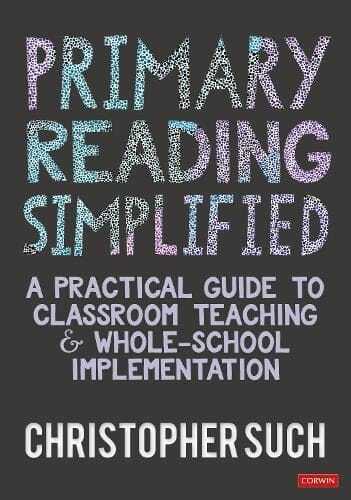 What research (and resources) to be interested in...
What research (and resources) to be interested in...Education Policy Institute have released a new 'Identifying SEND' report. It reveals chastening inequalities attending SEND support in different parts of the country. Alongside the 'postcode lottery', there are interesting insights, such as In the national cohort, girls were less likely than boys to be identified as having SEMH for the first time during secondary school, compared to boys. READ MORE HERE.
As secondary school summer exams loom in view, a new small study reveals some grim news about students' use of study strategies. 'An Evaluation of Secondary School Students’ Use and Understanding of Learning Strategies to Study and Revise for Science Examinations' surveys a sample of students, showing they still use outmoded strategies like rereading & highlighting over approaches more likely to work, such as self-testing and flashcard use. READ MORE HERE.
In the United States, the new Trump administration has begun significant cuts across government. These cuts have including effectively ending the work of the 'Institute of Eduction Sciences', or the IES, who undertake many trials and produce guidance for schools. A new article in The Conversation, entitled 'Helping teachers learn what works in the classroom − and what doesn’t − will get a lot harder without the Department of Education’s Institute of Education Sciences' explores the issues and makes a strong case for educational research. READ MORE HERE.
If you've been interested in my blogs, articles and 3Rs newsletter, you may be interested in investing in my latest book, 'Why Learning Fails (And What To To About It)', you can grab a copy with a discount HERE. If you want to bulk buy for your school, college or Trust, I can get up to 40% discounts for large orders.
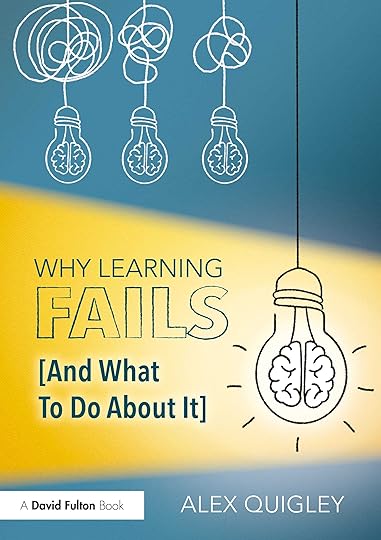
February 8, 2025
10 Wise Quotes on Teaching and Learning

Everyone has a view on education. Every parent and politician has sat in a classroom, so they have a view on what the teacher does or doesn't do. But experience does not always translate into wisdom and understanding.
Happily, we are not short of wisdom that does shine a light on the brilliantly complexity of teaching, learning, and education.
Here are 10 quotes that offer such wisdom:
"After 30 years of doing such work, I have concluded that classroom teaching...is perhaps the most complex, most challenging, and most demanding, subtle, nuanced, and frightening activity that our species has ever invented.” Lee Shulman
“Curriculum is like a suitcase. Every time you put something in, you have to take something out.” John Davies
3.
“Every teacher needs to improve, not because they are not good enough, but because they can be even better.” Dylan Wiliam
“Human intelligence is too rare and precious a thing to squander on a haphazard programme of instruction.” Philip H. Phoenix
5.
“Being attentive and engaged is equated with learning. However, students can be highly motivated and actively engaged in interesting classroom activities, yet not be learning anything new. Learning requires motivation, but motivation does not necessarily lead to learning.” Graham Nuthall
6.
“Do not teach too many subjects and what you teach, teach thoroughly.” Alfred North Whitehead
7.
“Instead of seeking bold ideas, grand ideas, creative ideas, or group commitment, we should be doing just the opposite: studying our practices closely and deliberately, deepening our understanding of the circumstances in which we work, and finding small and sustainable ways to improve.” Mary Kennedy
8.
“For change to succeed, leaders need to focus as much, if not more, on understanding the practices they wish to change as on designing the alternatives they seek to introduce. My reason for this claim is that the hardest part of change is not planning but its implementation because that involves the uncertain and complex process of integrating and aligning the new practices with hundreds of existing practices.” Viviane Robinson
9.
“The elementary school must assume as its sublime and most solemn responsibility the task of teaching every child to read. Any school that does not accomplish this has failed.” William J. Bennett
10.
"Any subject can be taught effectively in some intellectually honest form to any child at any stage of development.” J. S. Bruner
February 1, 2025
The 3Rs - Reading, writing, and research to be interested in #56
Alex Quigley's Blog
- Alex Quigley's profile
- 12 followers



